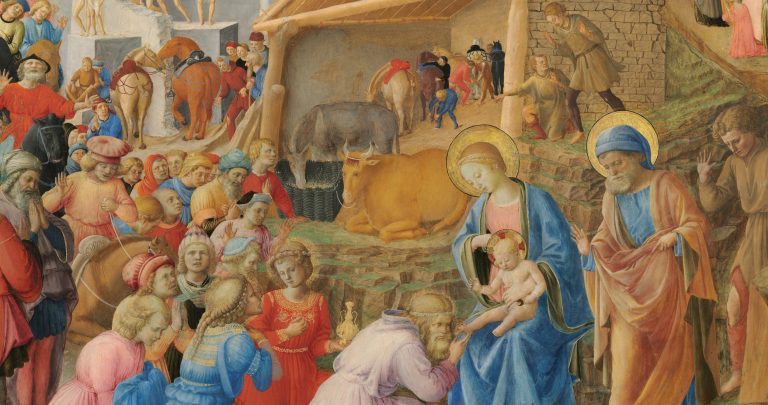By Edward Sri
Dr. Edward Sri is professor of theology and Scripture at the Augustine Institute’s Master’s in Catechetics and Evangelization program in Denver, Colorado. He is the author of numerous books, including God with Us: Encountering Jesus in the Gospel of Matthew.

Matthew, more than any other Gospel, is constantly making connections to that Old Testament story. Some scholars say he makes hundreds of allusions to stories, prophecies, prayers and teachings from the Jewish Scriptures. There are two main ways Matthew does this, and it’s crucial to know these two approaches if we want to follow his magnificent account of Christ’s life. Matthew uses (a) explicit fulfillment quotations and (b) implicit allusions to the Old Testament story. Both approaches beautifully demonstrate how God’s plan of salvation is brought to fulfillment in every little detail of Christ’s life. Thankfully, both approaches are very easy to see here in the first two chapters of Matthew’s Gospel—the accounts of Christ’s infancy and childhood.
First, Matthew uses fulfillment quotations. This is when Matthew pauses for a moment in his storytelling and spells out for us how a prophecy is being fulfilled. You can’t miss it. It’s as if he’s shouting out, “Hey, everyone! Did you notice what just happened here? What Jesus just did is a fulfillment of this prophecy from the Old Testament!”
One example of this is when the magi come to King Herod inquiring about a newborn king of the Jews. Herod asks the chief priests and scribes to tell him where the Messiah was expected to be born. They tell him, “In Bethlehem” and then go on to say, “for so it is written by the prophet”—which is the formulaic expression to draw attention to the fact that a prophecy is being fulfilled. And then he quotes the particular prophecy in mind—a prophecy from the Book of Micah: “And you, O Bethlehem, in the land of Judah, are by no means least among the rulers of Judah; for from you shall come a ruler” (Matt 2:5–6; cf. Mic 5:1; 2 Sam 5:2).
Do you see how easy Matthew makes it for us with these fulfillment quotations? Matthew uses this simple approach ten times in his Gospel, and half of those fulfillment quotations are found up front in Matthew 1–2 in the stories of Christ’s infancy and childhood (Matt 1:22–23; 2:5–6; 2:15; 2:17–18; 2:23).
Most of the time, however, Matthew doesn’t make it so easy. Some scholars point out that Matthew is constantly making subtle allusions to an Old Testament story and assumes you know the background and will easily make the connection. He assumes you as the reader know the Old Testament like young people today know lyrics from their favorite songs and lines from their favorite shows and movies.
The ancient Jews didn’t have baseball, Hollywood, iTunes, or Netflix. Their popular culture was shaped by the Scriptures. The stories of the Bible are what permeated their daily lives—what they talked about, what they heard in the Synagogue, what they pondered in prayer, what they celebrated and re-enacted in various feasts throughout the year. Matthew assumes that if he just quotes one line from a story or makes a few simple allusions, you’ll make the connection just like we do when we hear famous lines from our favorite songs, movies, and shows today.
Take, for example, the Christmas story about the magi. Matthew 2 tells of magi from the east who see a star over Israel and come to Herod in Jerusalem searching for a newborn king. Herod tells the magi to look for the Christ child in Bethlehem, saying, “Go and search diligently for the child, and when you have found him bring me word, that I too may come and worship him” (2:8). But he doesn’t really want to pay homage to the child. He just wants to know where the child is so he can kill him.
When the magi find the royal child, they offer him luxurious gifts fit for a king: gold, frankincense (an expensive perfume), and myrrh (an exotic spice). They fall down to worship him. But instead of reporting back to Herod, they return home by another way (Matt 2:10–12).
This story of the magi would have been very familiar to the Jews in the first century. It would have sounded like a “re-make” of an old song they had heard many times before: a wicked king, trying to use magi from the east to bring harm to Jesus, but the magi not going along with the king’s plan and instead blessing and honoring Jesus. That would remind them of a famous story in their tradition: the story of Balak and Balaam in the Book of Numbers 22–24.
Balak was the wicked king of Moab who wanted to bring harm to the Israelites who were approaching the Promised Land. Balak calls upon a man named Balaam, a wise man from the East, to put a curse on the people of Israel. But every time he tries to curse the Israelites, God intervenes and words of blessing come out of his mouth. Instead of cursing Israel, he blesses Israel!
All this, of course, foreshadows the events surrounding Christ’s birth. Just as the wicked King Balaak attempts to employ a seer from the east named Balaam to harm Israel, so the wicked King Herod tries to use the magi from the east in his plot to discover where the Christ child is. Just as Balaam didn’t cooperate with Balak’s plan, blessing Israel instead of cursing the people, so the magi didn’t assist in Herod’s plan, paying homage to the baby Jesus and not revealing his location to Herod.
But the most fascinating connection is found in how the story of Balak and Balaam ends. After three attempts to curse Israel, Balaam finds God’s speech taking over once again, but this time, Balaam utters a prophecy about some great king coming to Israel in the distant future:
I see him, but not now; I behold him, but not near; A star shall come forth out of Jacob, And a scepter shall rise out of Israel. (Num 24:17)
Let’s unpack the symbolism in this prophecy. The scepter is a royal staff, symbolizing a king who will one day come to Israel. And according to this prophecy, a star will be the sign of the king’s coming. So when the magi see the star in the direction of Israel, their coming to Jerusalem in search of a king would make perfect sense to the first century Israelite—it’s just what Balaam had prophesied long ago. In this sense, the magi in the Christmas story are like successors to Balaam in that they worship the king whom Balaam foretold many centuries ago.
You Might Also Like

Much has been said about why Jesus died. This book focuses on why Jesus lived. God with Us: Encountering Jesus in the Gospel of Matthew shows that Jesus didn’t just come to be our teacher, a miracle work or prophet, or even just Israel’s savior and redeemer. Jesus is Emmanuel, God with us. Notable Scripture scholar Edward Sri leads readers on a faithful exploration of Jesus’s kingdom-building mission and how it revealed God presence, which remains with us today.